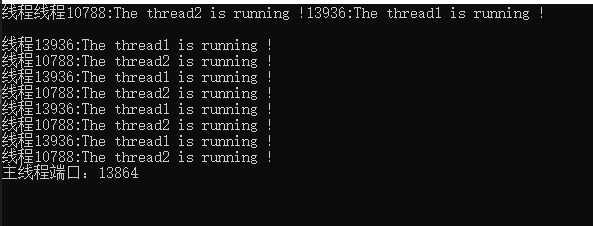上一次讲述了多线程编程,但是由于线程是共享内存空间和资源的,这就导致:在使用多线程的时候,对于共享资源的控制要做的很好。先上程序:
1 #include <iostream> 2 #include <thread> 3 #include <chrono> 4 #include <mutex> 5 6 using namespace std; 7 8 mutex mtx; 9 10 void fn1() 11 { 12 for (int i = 0; i < 5; i++) 13 { 14 mtx.lock(); 15 cout << "线程" << this_thread::get_id() << ":" << "The thread1 is running !" << endl; 16 mtx.unlock(); 17 } 18 } 19 20 void fn2() 21 { 22 for (int i = 0; i < 5; i++) 23 { 24 mtx.lock();//锁住的是什么资源,什么时候加锁? 25 cout << "线程" << this_thread::get_id() << ":" << "The thread2 is running !" << endl; 26 mtx.unlock(); 27 } 28 } 29 30 int main() 31 { 32 thread t1(fn1); 33 thread t2(fn2); 34 t1.detach();//this_thread是否表示当前进行,而这里的当前进程是否是main函数所在进程 35 t2.detach(); 36 this_thread::sleep_for(chrono::milliseconds(1000));//sleep_for表示当前进行休眠一段时间,不与其他进程竞争CPU 37 cout << "主线程端口:" << this_thread::get_id() << endl; 38 getchar(); 39 return 0; 40 }
上面一段程序,在main进程中创建了两个子线程t1,t2。对各个子线程的cout输出流进行了加锁,完了又对锁进行了释放。
其结果如下:

可见:线程t1,t2是交替执行的(这是由CPU时间片轮换造成的?)。假如我们不对cout输出流加锁,我们看看代码:
1 #include <iostream> 2 #include <thread> 3 #include <chrono> 4 #include <mutex> 5 6 using namespace std; 7 8 mutex mtx; 9 10 void fn1() 11 { 12 for (int i = 0; i < 5; i++) 13 { 14 //mtx.lock(); 15 cout << "线程" << this_thread::get_id() << ":" << "The thread1 is running !" << endl; 16 //mtx.unlock(); 17 } 18 } 19 20 void fn2() 21 { 22 for (int i = 0; i < 5; i++) 23 { 24 //mtx.lock();//锁住的是什么资源,什么时候加锁? 25 cout << "线程" << this_thread::get_id() << ":" << "The thread2 is running !" << endl; 26 //mtx.unlock(); 27 } 28 } 29 30 int main() 31 { 32 thread t1(fn1); 33 thread t2(fn2); 34 t1.detach();//this_thread是否表示当前进行,而这里的当前进程是否是main函数所在进程 35 t2.detach(); 36 this_thread::sleep_for(chrono::milliseconds(1000));//sleep_for表示当前进行休眠一段时间,不与其他进程竞争CPU 37 cout << "主线程端口:" << this_thread::get_id() << endl; 38 getchar(); 39 return 0; 40 }
(就是单纯的注释掉了加锁)。
结果如下:

可以看到,结果产生了紊乱,分析一下这个结果:
线程t1才执行了一点:刚输出完“线程”两个字,转到线程2执行了,接下来再输出了线程t1的内容(并不是跑回去执行线程t1),再去执行线程t1.
造成这种紊乱的原因是:
cout本质上是一个输出流对象,相当于一个公共接口,这个接口是一个公共资源。这里就涉及到了资源共享的问题!!!
所以要对cout这个共享资源加锁!!!这样等当前的输出流执行完,才会到下一个线程!!